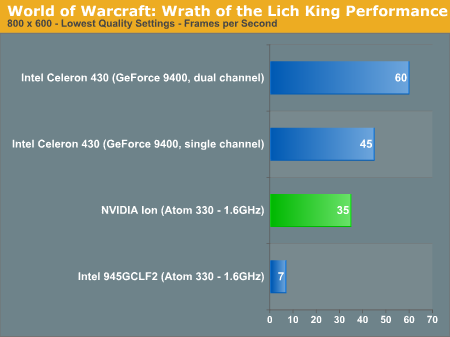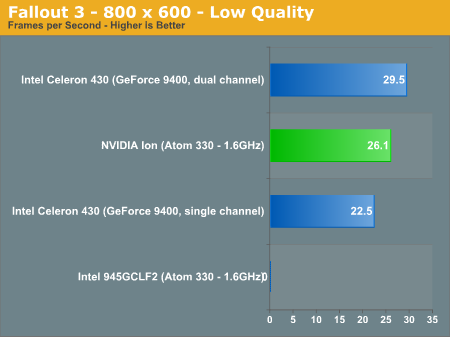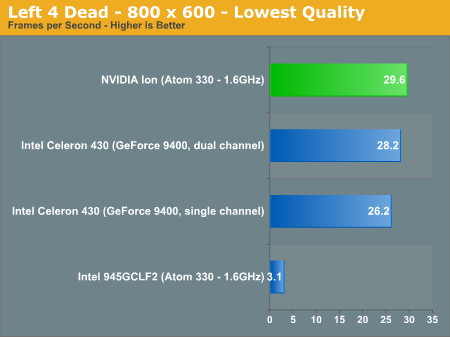NVIDIA's Ion Platform: Performance Preview
by Anand Lal Shimpi on February 3, 2009 9:01 AM EST- Posted in
- GPUs
Gaming Performance: The Other Advantage
The GeForce 9400M that is spec’d for NVIDIA’s Ion platform is the same 9400M used in full sized notebooks. It’s a 16 SP core running at 550MHz with a 1.4GHz shader clock. While you can’t game on a standard Atom system, it is possible to do so on an Ion machine.
Gaming performance is no contest. This is truly the advantage of Ion. At the lowest possible quality settings in World of Warcraft the Atom/945G platform delivered an average of 7 frames per second in our test. Hardly playable.

Ion managed a smooth 35 fps. While it’s not fast enough where you can go crazy with the detail settings, it is possible to get your WoW fix on an Ion based netbook while it isn’t on a standard netbook configuration. Note that simply moving to a low end Celeron improves performance considerably. Move to a Celeron and use two channels of DDR2 memory and you get another performance boost.
Fallout 3 is an even more clear-cut victory. We still have to run at the lowest quality settings to even get something playable, but at least it can run. On the 945G based Atom board Fallout 3 wouldn’t even run without crashing.

The Ion platform actually has an advantage here: it's got more memory bandwidth. I have to populate two DDR2 DIMM slots on the Celeron board in order to actually show a performance advantage over Ion.
Under World of Warcraft the Ion was only 5x the speed of Intel’s Atom/945G. Left 4 Dead however proves to be more GPU dependent and runs at nearly 10x the speed on Ion as it does on Intel’s 945G. While I wouldn’t want to play Left 4 Dead on any Atom machine, it’s at least remotely possible on an Ion.

Left 4 Dead is actually slightly faster on Ion than on our Celeron 430 testbed. I suspect this (and the Fallout 3 behavior) is due to the Celeron 430 being a single-core, single threaded processor while the dual core Atom in the Ion can work on four threads at once.










69 Comments
View All Comments
chizow - Tuesday, February 3, 2009 - link
Certainly getting ahead of myself a bit, but I wouldn't be shocked if Nvidia starts moving in this direction with a low-cost, decent performing fixed hardware PC gaming platform. All you'd need is slightly faster CPU and GPU, throw in a cheap GPU for dedicated PhysX.The ability to web-surf and play Blu-Ray back on a small platform is certainly interesting though. I agree they'll need to improve the aesthetics a bit on the housing, but for $200-300, the same price as a stand-alone Blu-Ray player, the Ion would certainly be a compelling option.
I think some of the road blocks would be the Blu-Ray drive itself, whether you could actually play Blu-Ray media. Relying on streaming or ripped copies would make the tech much less appealing. Also, how about outputs? Is the Ion able to output 8ch LPCM or lossless bitstreams like DTS-HD or TrueHD? Anyways, looks interesting for sure and certainly a nice alternative to Intel's gimpy Atom chipset/platform.
JimmiG - Tuesday, February 3, 2009 - link
To be honest, I don't think a more powerful GPU would have changed the way I use my Aspire One netbook.There's no need to be able to watch blu-ray movies, because lower resolution DivX etc. looks just as good on the 8.9” screen, and you can store a lot more of it locally (the system obviously lacks an optical drive).
As for games, I might have installed a couple of games just for fun to see how awful they run. But I would quickly grow bored with them. Why play games at the lowest settings at 800x600 on a tiny screen using a mini-keyboard and at best a flimsy laptop mouse, when I've got a 22” monitor hooked up to a quad-core machine with 4850 graphics in the other room? If I was serious about playing games on the move, I would have skipped my desktop system altogether and bought a gaming notebook.
It might be somewhat useful as a HTPC. The usefulness of the EeeBox in such a setting was severely limited by the poor graphics performance. On the other hand, you could just as easily get a small, stylish u-ATX case and build something around a cheap Athlon X2 or low-end Core2 Duo/Pentium Dual Core. With a PCI-E x16 slot, you could even install a decent videocard (4830) and not only use the system to play HD video, but also play the latest games on the living room TV. The system would only be slightly larger and hardly louder, but the cost would be about the same and you'd get a much more flexible system,
cosmotic - Tuesday, February 3, 2009 - link
How about older games with potentially playable frame rates like Quake3, Warcraft3, and maybe even UT2004?cosmotic - Tuesday, February 3, 2009 - link
I think you are confusing CODECs with compression algorithms. The CODEC you are using in these tests is Cyberlink's h.264 CODEC which is a) tightly coupled to Cyberlink's super-crappy player, and b) (and im guessing here) only available in Cyberlink's super-crappy player. This isn't unexpected considering basically every other hardware accelerated decoder works the same way. However, I really wish that hardware decoder manufactueres would realize that it would be worlds more useful to users for their chips to ship with Generic DirectShow h.264 CODECs which could be used in ANY DirectShow based program.Please Anand, tell me I'm wrong and that the Cyberlink Player is actually running off of a DirectShow CODEC which is available to any other application!!! (in which case, why are you using that crap software?)
BikeDude - Tuesday, February 3, 2009 - link
I would like to know the same thing myself. (I am certainly no Cyberlink fan -- they have a buggy codebase mixed with terrible support)Also: Is the PureVideo codec payware, or will this thing come with it bundled? (I assume PureVideo HD _is_ DirectShow)
cosmotic - Tuesday, February 3, 2009 - link
Last I checked, PureVideo is a player using it's own CODEC. I think it's up to the OEM to pay to include it with their cards and I dont think any of them do, or if they do, they include what amount to 'lite' versions of old versions. I'm guessing nVidia decided to forgo maintaining their own player and just let Cyberlink handle all that. Even their website says to buy PowerDVD instead of PureVideo if you're running vista.QChronoD - Tuesday, February 3, 2009 - link
So the Ion won't do decoding on the graphics chip if you are playing a random .mkv through VLC???apanloco - Tuesday, February 3, 2009 - link
That's correct. It won't.sprockkets - Wednesday, February 4, 2009 - link
I've played 720p content on a dual core atom platform with VLC, but it works only if you turn off the deblocking of h264, which kills most of what makes h264 look so nice. Forget about 1080p.xRyanCat - Tuesday, February 3, 2009 - link
PureVideo is just marketing lingo for GPU accelerated video. All cards from 6600GT and up (I have a 6600GT, but it might apply to earlier cards) can offload a certain amount of CPU load to the GPU. With a 6600GT and an Athlon 64 3200+ (@2.5GHz) a 1080p video results in about 60%-80% constant CPU usage. Without GPU acceleration even 720p videos are unplayable. And VLC supports offsetting load to the GPU on Linux and Windows platforms. I know gXine also has the same support on Linux.I can't see why it wouldn't work.